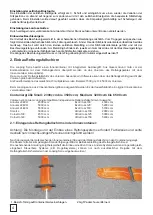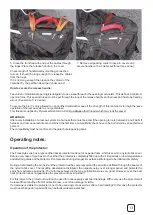
Adjustment possibilities:
Adjustment possibilities are existing at the shoulder belts, the chest belt, the lateral chest belts and the leg straps.
By the versatile adjusting possibilities of the Looping series we recommend in any case that all adjustments and settings
are done in a simulator
before
the first flight to guarantee an optimal comfort.
The buckles of the chest and leg straps are secured against unintentional opening. To open these buckles you have to
push both buttons of the buckle at the same time.
Looping Green:
Adjustment of chest belt:
The chest belt and the leg belts are closed together by 2 buckles (Get-Up System). The buckles must be closed audibly!
The length of the chest belt can be adjusted by the plastic buckle and should not be tightened too much.
Adjustment of the leg belts:
The length of the leg belts can be adjusted by the two buckles underneath the seatboard. They are accessible from the
top. The lenght should not be too short or too long, that after the take off a easy slipping into the harness and an easy raise
up for landing is possible.
Looping Blue:
Adjustment of chest belt:
The chest belt is closed by the T-buckle. If the chest belt is closed, also the falling out safety device (Safe-T-System) is
closed. The buckles must be closed audibly! The length of the chest belt can be adjusted and should not be tightened too
much.
Adjustment of the leg belts:
When you put the harness on, please take care that the buckles are closed correct and audible. The leg belts should be
fastened tight but should leave your legs still enough space to move during take off and landing phase.
Looping Blue - Looping Green
Adjustment of shoulder belts:
Please note that with correct adjusting the shoulder belts are felt with light pressure on the shoulders. With the shoulder
belts you adjust the harness on the pilot’s height, but also you adjust the seating position between upright and lying.
Adjustment of lateral chest belts:
Adjusting the lateral chest belts take place as the third step and offers on one side again the variation of the seating
position. On the other hand you adjust with the lateral chest belts the most comfortable seating position. During the
adjustment pay attention to the fact that the body load is distributed equal on shoulder belt and lateral chest belt.
Adjustment of lordosis belt:
By lengthing or shortening of belt h) the pressure on the lower back can be varied.
Attaching the speed bar:
You can see in the schematic description how the speedbar rope is running. The rope of the speedbar runs down from the
risers to the pulley above the seatboard. Then through the guiding tube. The rope will leave the harness through the
frontal edge. The rope is guided through the small lateral D-ring at the frontal edge of the seatboard. Here the line gets
connected to the speedbar.
The length of the speedbar’s line must be adjusted in a simulator before flight!
2. Mounting the rescue parachute
The Looping serie has got a deployment bag with integrated release handle. Out of this reason you have to find out the
right size of the deployment bag before mounting the rescue parachute.
Therefore you need to know the volume of the rescue parachute. If it is not shown in the parachute manual, you can
alternatively determine the volume of the rescue parachute by checking it’s weight.
As a rule of thumb multiply the weight by 3. For example: 1500 gr x 3 = 4500 ccm Volumen
You have the choice of two deployment bag sizes. Only an original deployment bag is allowed to be used.
Container size small: 2300 ccm to 3500 ccm; Container size medium: 3200 ccm to 6500 ccm
Volumes of Independence rescue parachutes which are compatible with the Looping serie (selection only):
Annular 20 EVO:
4500 ccm
Evo Cross 100:
4500 ccm
Annular 22 EVO:
5000 ccm
Evo Cross 120:
5200 ccm
Annular 24 EVO:
5500 ccm
Evo Cross 160:
5700 ccm
Smart L:
5000 ccm
Ultra Cross 100:
2980 ccm
Cornetto 100:
4510 ccm
Ultra Cross 125:
5000 ccm
Cornetto 140:
5000 ccm
Ultra Cross 150:
5400 ccm
2.1. Placing the rescue parachute into the innercontainer:
Caution: The mounting and installation of a rescue system requires expert knowledge and should be
carried out only by qualified persons!
After you have choosen the right innercontainer size the rescue parachute is to be placed into the deployment bag. The
steps of packing until you have reached the shown status below, has to be done according the rescue parachute manual!
The following guide shows the assembling of an Evo Cross. Other systems have to be build in the same way
analogously. Please check if there are special remarks in your parachute manual!
Steerable systems (example Rogallo systems) can be installed in the Looping serie only with explicit approval of the
rescue parachute manufacturer!
2. Remove the packing cord!
1. Fold the parachute like a “S” on the width of the
deployment bag.
10
11
i)
e)
f) rescue system release handle with deployment bag
g) lateral chest belt / adjustment buckle
h) adjustment buckle Lordose
i) guiding ring + elastic rope for speed bar
j) pulley for speed bar line
k) guiding tube for speed bar line
l) shoulder belt with adjustment buckle
rescue system container
m) attachment point for rescue system
n) Airbag - protector
o) air intake for airbag
p) storage bag
q) channel for rescue system bridle
r) velcro attachment speed bar
s) magnet attachment speed bar
e)
f)
g)
h)
m)
n)
o)
n)
p)
p)
r)
s)
s)
l)
q)


































